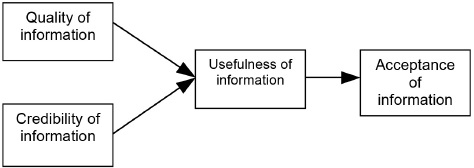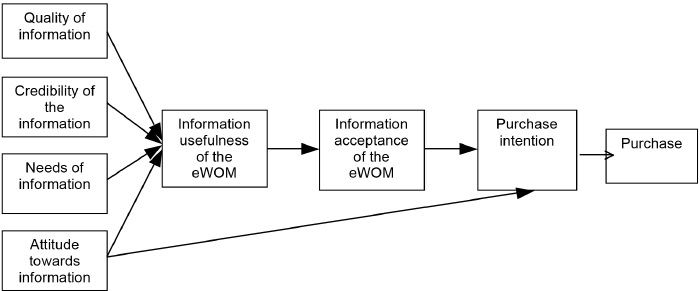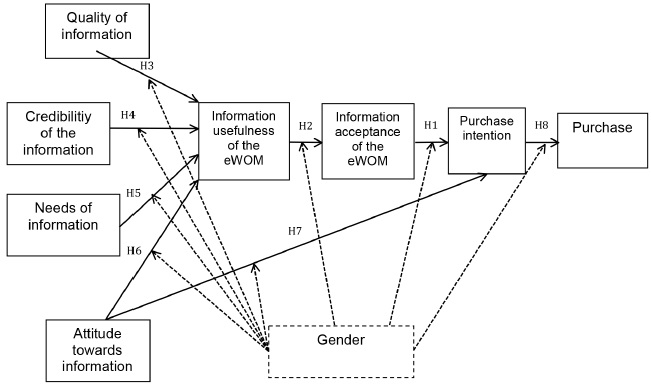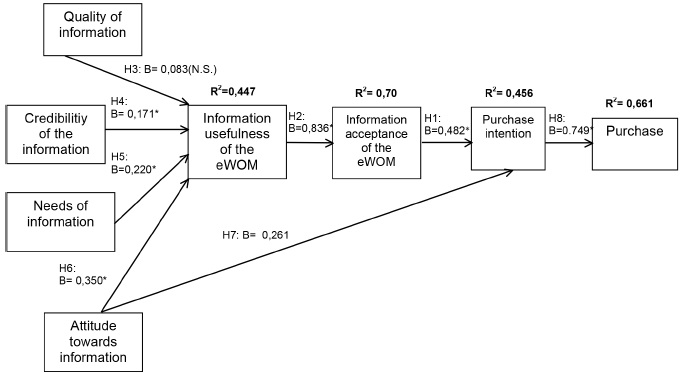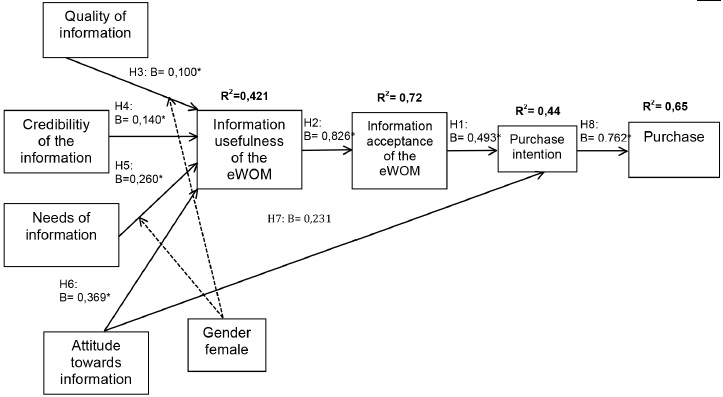Introduction
Internet has allowed consumers to participate in the creation of brand value, since it is a channel where customers can share their opinions about the characteristics of products and services, and about their experiences with the purchase or use of products, information directly related to perceptions about satisfaction and brand loyalty that affects positively or negatively the image and positioning of companies in the market (Oviedo García, Muñoz Expósito, & Castellanos-Verdugo, 2015). This way, the change in the role of customers is oriented towards cooperation, coproduction and co-creation of value, a fact that has generated a high degree of connection among people, allowing them to be permanently informed about the best alternatives for the products and services they want to buy.
In recent years, electronic Word of Mouth (eWOM) has been researched in different areas related to digital marketing (Ba, 2002; Bailey, 2004; C. M. K. Cheung & Thadani, 2012; Cheung, Lee, & Rabjohn, 2008; Hennig-Thurau & Walsh, 2003; Ward & Ostrom, 2006). Hennig-Thurau, Gwinner, Walsh, & Gremler (2004) defined eWOM as ‘any positive or negative statement made by potential, actual, or former customers about a product or company, which is made available to a multitude of people and institutions via the Internet’. These interactions are expressed through different mechanisms provided by Social Media, with the following being the most widely researched and developed ones according to Rejón-Guardia, Fernandez & Leiva (2013): discussion forums, boycott websites (Hennig-Thurau et al., 2004), news groups, chat rooms, user groups, personal and corporate blogs, general social networking sites, specialist travel and tourism networks, specialist music networks and microblogging sites (Goldsmith & Horowitz, 2006). Social networking sites, such as Facebook, Twitter or Instagram, have become an efficient and popular channel to share consumer-generated content, thus allowing them to interact with each other in a convenient and instantaneous manner (Sánchez-Torres & Arroyo-Cañada, 2016). In this context, eWOM is enhanced with the exchange of information about products and services via the internet, which is considered credible and reliable by consumers (Rejón-Guardia et al., 2013). Additionally, certain differences can be seen in the use made of those opinions by males and females (Chan, Cheung, Shi, & Lee, 2015), and therefore gender is a variable to be considered in the development of online marketing and reputation management strategies.
The aim of this research is to examine the influence of eWOM in the purchase intention of users of social networking sites in Spain and to determine if there is a moderating effect of the variable gender. From the Information Acceptance Model (IACM) proposed by Erkan & Evans (2016), the determining factors of eWOM usefulness and its relationship with purchase intention are examined, taking into account possible differences between males and females.
Theoretical background
eWOM
The first studies on eWOM were presented by (Wu, Mahajan, & Balasubramanian, 2003) about the motivations of people to participate in the internet with reviews or ratings on products, services or companies and proposed three motivating factors (focus-related utility, consumption utility and approval utility). Hennig-Thurau et al. (2004) extended the motives behind eWOM to eight: venting negative feelings, concern for other consumers, selfenhancement, seeking advice, social benefits, economic incentives, platform assistance and helping the company. In this same line, Goldsmith & Horowitz (2006) posit that eWOM is more relevant than advertising since it is free of the social prejudices inherent to convenience answers, and define eight motives for consumers to use this information (to reduce their risk, because others do it, to secure lower prices, to get information easily, by accident/unplanned, because it is cool, because they are stimulated by off-line inputs such as TV and to get prepurchase). In the last years, the rapid advance of social networking sites, as the leaders within the Social Media environment, has lead to a reorientation of the studies on eWOM information towards the study of its dynamics in this type of networks. Authors such as Chu & Kim (2011) have proposed a set of variables based on the social theory that can have a positive effect on the development of eWOM (homophily, trust, normative influence and informational influence), such as the notion that those individuals with a higher number of social ties can establish contact with a higher number of people, which increases the possibilities of influencing others and, therefore, the strength of ties makes eWOM become a far-reaching tool (Rejón-Guardia et al., 2013). Specifically in social networking sites, eWOM information has proven to have direct effects on brand satisfaction, brand loyalty and brand image (Balaji, Khong, & Chong, 2016). Finally, studies on eWOM emphasize the influence on the final purchase decision for a product, with this having a direct effect on questions such as the perceived value of the product (Gruen, Osmonbekov, & Czaplewski, 2006) and purchase intention (Matute Vallejo, Polo Redondo, & Utrillas Acerete, 2015; Salo & Frank, 2015; Wang, Yu, & Wei, 2012), Nevertheless, the most recent studies examine how the acceptance of eWOM information affects both the attitude and the purchase decision (Matute-Vallejo et al., 2015; Erkan & Evans, 2016).
eWOM Information Acceptation Model (IACM) for the purchase
Erkan & Evans (2016) posit that the influence of eWOM on the purchase or repurchase decision requires the sum of two variables: the characteristics of the information and the attitude of consumers that adopt such information. Information from eWOM is found in different formal and informal virtual channels (blogs, social networking sites, forums or virtual communities), and is shared in different ways (reviews on brands, comments, messages between users or simple thoughts) where consumers can provide information to other consumers by means of online consumer reviews of products which can affect the buying decision (Matute-Vallejo et al., 2015). Consumers assess this information to determine its usefulness in the purchase decisionmaking process, repurchase decision-making or to strengthen the loyalty bonds with a brand (Erkan & Evans, 2016). Previous studies have used several models and theories to examine consumers’ information acceptance. Regarding eWOM, the firs studies analysed the transfer of basic information between senders and receivers (Bansal & Voyer, 2000). Cheung et al. (2008) pointed out that the influence of the information might change from person to person and that the same content can evoke different notions among receivers. Based on these preliminary studies, and adopting behavioural theories, authors such as Sussman & Siegal (2003) or Shen, Cheung, & Lee (2013), propose to integrate this knowledge with the Dual Process Theory, which posits that people can be affected by a message in two routes, which are central and peripheral. The central route refers to the essence of arguments within the message, while the peripheral route refers to issues which are indirectly related to the essence of the message (Petty & Cacioppo, 1988; Cheung et al., 2008; Shu & Scott, 2014). From these contributions, the Information Acceptance Model (IAM), which is based on the theory of Technology Acceptation Model (TAM) proposed by Davis (1989), was developed. Therefore the model includes four components: argument quality (which represents the central route), source credibility (which represents the peripheral route), information usefulness and information acceptance (Sussman & Siegal, 2003), as illustrated in Figure 1. With this integration, the IAM offers an explanation as to how people are affected by the information on computer mediated communication platforms. IAM models applied to the eWOM are made of three variables (quality of the information, credibility and usefulness of the information), which have direct effects on consumers’ information acceptance (Cheung et al., 2008; Chu & Kim, 2011; Shu & Scott, 2014). In particular, Cheung et al. (2008) has applied this model within the online discussion forums context, while it was applied by Chu & Kim (2011) within the social media context.
Nonetheless, although IAM is a commonly used model in eWOM, it only focuses on the characteristics of information. The influence of information, however, should not be limited to the characteristics of information, consumer behaviour towards information should be evaluated together with them, according to the model developed by Erkan & Evans (2016) and to the theoretical framework proposed by Knoll (2016), who add consumers’ attitude towards information, as illustrated in Figure 2.
Information acceptance and purchase intention
Recent studies have shown that there is a significant relationship between the acceptance of eWOM information and the use of such information for the purchase and repurchase of products and services, in social networking sites (Wang et al., 2012), vendor’s websites (Matute Vallejo et al., 2015) or social media in general (Erkan & Evans, 2016). This relationship is basically supported by all the technological adoption models applied to electronic purchases therefore (Davis, 1989; Fishbein & Ajzen, 1975; Venkatesh, Morris, Davis, & Davis, 2003; Venkatesh, Thong, Xu, 2012) the following hypothesis is proposed:
Usefulness and information acceptance
The technology acceptance model (TAM), proposed by Davis (1989), Davis, Bagozzi & Warshaw (1992), and the empirical applications of the model (Cheung et al., 2009; Venkatesh et al., 2003; Venkatesh et al., 2012) posit a positive relationship between the perception of technology usefulness and technology use, which has been validated by Erkan & Evans (2016) and Sussman & Siegal, (2003) for eWOM information from social media and others. Therefore, the following hypothesis is proposed:
Quality and credibility of eWOM information
Research works such as those carried out by Petty & Cacioppo, (1988), Park et al. (2007) and Lee & Shin (2014) postulate that the quality of online reviews has a positive influence on purchase intention, and consequently the quality of eWOM information can be one of the determinant factors of consumers’ purchase intentions as it is proposed by Erkan & Evans (2016). Therefore, the following hypothesis is introduced:
According to (Wathen & Burkell, 2002), information credibility is the initial factor in the individuals’ persuasion process, and it is a previous factor of the perceived usefulness according to the IAM. Therefore, the following hypothesis is proposed:
Needs of information and attitude towards information
Needs of information is another pillar of information acceptance, with this being the main motivator for eWOM engagement (Sundaram & Hills, 1998). Subsequent studies have used this same notion as “advice seeking” (Hennig-Thurau et al., 2004) and “opinion seeking” (Chu, 2010). The study carried out by Erkan & Evans (2016) added that people who search for information on social media, are more likely to find such information more useful in their purchase decision-making process.
Finally, the model proposed integrates the variable attitude towards the use of eWOM information, similarly to studies on purchasing behaviours: theory of reasoned action (Fishbein & Ajzen, 1975), theory of planned behaviour (Ajzen, 1991) and TAM (Davis, et al., 1992). Based on these relationships with intention and purchase, Erkan & Evans (2016) postulate and validate the relationship between attitude towards information and purchase intention for eWOM. Therefore, the attitude of social media users towards eWOM information can have a positive effect on the usefulness of such information and on consumers’ purchase intentions (Figure 3). Thus, the following hypotheses are proposed:
H6: Attitude towards eWOM information is positively related to usefulness of eWOM information.
H7: Attitude towards eWOM information is positively related to consumers’ purchase intention.
H8: Purchase intention from eWOM information acceptation is positively related to purchase.
Differences between males and females in the use of internet
The differences by gender in internet usage are based in the online information seeking behaviour of males and females in relation to usefulness. Several studies have shown that males tend to use internet in an utilitarian way, while females are more emotional towards shopping, for example (Alreck & Settle, 2002; Çelik & Yilmaz, 2011; Venkatesh et al., 2012; Arroyo-Cañada & Gil-Lafuente, 2014). For the case of online information, the study conducted by Chiu et al. (2009) concludes that males tend to consider more valuable those activities that provide an enjoyable experience online, such the use of games or videos, while females consider more valuable those activities that allow them to have better personal relationships, such as chat rooms or instant messaging. Therefore, it can be assumed that in the acceptance of eWOM information for the purchase decision-making process, females will tend to attach higher importance to this type of information than males, and therefore the following hypothesis is proposed:
Methodology
Measurement tool
In order to contribute to the study into the adaptation of eWOM information in Spain, this research intends to adapt the measurement scales used in the literature. Taking as a reference the scales used in the IACM, a total of 24 items to measure the 8 constructs have been adopted.
Specifically, three items were used for each one of the following constructs: attitude towards information (Park et al., 2007; Erkan & Evans, 2016), quality, need, information usefulness and information acceptance (Prendergast et al., 2010; Chu & Kim, 2011; Erkan & Evans, 2016). For credibility of information, four measurement items were used (Prendergast et al., 2010; Erkan & Evans, 2016), three items for purchase intention and two for purchase, based on the scales used by Park et al. (2007) and Erkan & Evans (2016). The complete measurement scales can be found in Appendix 1.
The information was collected through an online questionnaire with seven-point Likert scale, ranging from 1 (strongly disagree) to 7 (strongly agree), following the guidelines recommended by Churchill & Iacobucci (2004) to effectively measure variables that are not directly observable.
Sample and data collection
Due to the fact that this is a study on users of social networking sites, the following target population was chosen: males and females from 20 to 40 years old, users of internet and social networking sites in Spain, at least 3 times a week. The data collection method chosen was online survey, for this being an information collection tool that has already been validated in other studies for this type of research (Escobar-Rodríguez & Carvajal-Trujillo, 2014; Agudo-Peregrina, 2014). A total of 279 questionnaires were collected; eight of them contained consistency problems in the answers, and therefore the final sample was made of 271 valid questionnaires collected in the period April-May 2016 (Appendix 2).
Analysis of the data and results
In order to estimate the structural equation model proposed, a regression analysis of latent variables was carried through the technique of Partial Least Squares (PLS), using the Smartplus PLS program. This multivariate technique to test structural models is recommended in models of novel character and for small samples (Escobar-Rodríguez & Carvajal-Trujillo, 2014; Matute Vallejo et al., 2015).
The data analysis was carried out in three phases: in the first phase the measurement model was tested, in the second phase the validation of the structural model was examined, while the third one analysed, by using a multi-group test, whether there are differences between males and females in the relationships included in the model.
Validation of the measurement model
The first step is to determine the convergent and discriminant validity of the constructs and the reliability of each item. The convergent validity of each construct is acceptable, since all them have loadings above 0.5 in the convergent validity test (Hair et al., 2014). The individual reliability of each item is measured by the correlations of the loadings of each item versus each variable. In Table 1, it can be verified that the loadings for each indicator are significant (t >1.96), with all them being validated (Table 1). Additionally, in order to test the internal measurement coherence of all the indicators in relation to their corresponding variables, the Dillon-Goldstein’s test, known as the composite reliability coefficient, is applied, where all the values are above the minimum acceptable of 0.7 (Gefen et al., 2000). Then the Cronbach’s alpha test is applied and all the values above 0.7 are obtained, complying with the minimum values (Churchill & Iacobucci, 2004). Finally, the convergent validity is tested again, taking into account the variance, that is to say, that there is a similar variance between the indicators and its construct, which implies that the average variance extracted must exceed the cut offpoint of 0.5 explained by the indicators (Fornell & Larcker, 1981), as can be seen in Table 2.
Table 1 Items loadings and t-values.
| Items | Loadings | t-value |
|---|---|---|
| ATI1 | 0.871 | 37.869 |
| ATI2 | 0.914 | 77.783 |
| ATI3 | 0.858 | 45.673 |
| IA1 | 0.936 | 104.894 |
| IA2 | 0.944 | 106.877 |
| IA3 | 0.946 | 137.074 |
| IC1 | 0.770 | 23.177 |
| IC2 | 0.842 | 30.205 |
| IC3 | 0.890 | 65.209 |
| IC4 | 0.839 | 34.436 |
| IQ1 | 0.849 | 27.917 |
| IQ2 | 0.885 | 38.673 |
| IQ3 | 0.821 | 32.229 |
| IU1 | 0.918 | 88.468 |
| IU2 | 0.938 | 106.224 |
| IU3 | 0.905 | 62.762 |
| NOI1 | 0.848 | 28.113 |
| NOI2 | 0.903 | 66.973 |
| NOI3 | 0.734 | 14.966 |
| P1 | 0.902 | 66.320 |
| P2 | 0.902 | 56.856 |
| P3 | 0.848 | 37.702 |
| PI1 | 0.875 | 45.891 |
| PI2 | 0.852 | 36.158 |
| PI3 | 0.857 | 43.276 |
Source: by author.
Table 2 Convergent validity of the variables.
| Variables | Cronbach´s Alpha | Composite reliability | Average Variance Extracted (AVE) |
|---|---|---|---|
| ATI | 0.856 | 0.912 | 0.776 |
| IA | 0.937 | 0.959 | 0.887 |
| IC | 0.856 | 0.903 | 0.699 |
| IQ | 0.812 | 0.888 | 0.726 |
| IU | 0.910 | 0.943 | 0.847 |
| NOI | 0.775 | 0.870 | 0.692 |
| P | 0.861 | 0.915 | 0.782 |
| PI | 0.826 | 0.896 | 0.742 |
Source: by authors
The discriminant validity is tested through the comparison between the average variance extracted (AVE) of each variable with the squared correlation between the variables, with all the values obtained for the main diagonal (AVE) exceeding the squared correlations. The matrix shows that each variable relates more intensely to its own items than to the items of the other variables since, the values below the diagonal are smaller than the AVE (Fornell & Larcker, 1981), as shown in Table 3.
Table 3 Discriminant validity of the variables.
| ATI | IA | IC | IQ | IU | NOI | P | PI | |
|---|---|---|---|---|---|---|---|---|
| ATI | 0.881 | |||||||
| IA | 0.617 | 0.942 | ||||||
| IC | 0.421 | 0.485 | 0.836 | |||||
| IQ | 0.375 | 0.383 | 0.670 | 0.852 | ||||
| IU | 0.594 | 0.836 | 0.479 | 0.415 | 0.921 | |||
| NOI | 0.639 | 0.525 | 0.477 | 0.392 | 0.558 | 0.832 | ||
| P | 0.536 | 0.616 | 0.440 | 0.406 | 0.564 | 0.455 | 0.884 | |
| PI | 0.558 | 0.643 | 0.527 | 0.492 | 0.634 | 0.553 | 0.749 | 0.861 |
Source: by authors.
Therefore, it can be considered that each variable relates more intensely to its own items than to the items of the other variables (Fornell & Larcker, 1981), as shown in Table 3.
Validation of the structural model
Following with the structural model, a resampling is carried out by the bootstrapping technique, using 1,000 sub-samples extracted from the same research data in order to perform a significance contrast of the parameters included in the model, on the basis that the model has fulfilled its predictive power since the R-square values exceed 0.1 (Hair et al., 2014). The results from the bootstrapping test support the relationships proposed, with all hypotheses being significant, except for the relationship between the variable quality of information and usefulness of information. Therefore all hypotheses are supported, except for hypothesis H3, which is not significant, as can be seen in Table 4 and Figure 4.
Table 4 Summary of the structural validity of the model.
| Hipotheses | Effect | Original Sample | R square | Standard Deviation | T Statistics | P Values |
|---|---|---|---|---|---|---|
| H3 | IQ -> IU | 0.083 (N.S.) | 0.064 | 0.292 | 0.197 | |
| H4 | IC -> IU | 0.171* | IU = 0,447 | 0.063 | 2.714 | 0.007 |
| H5 | NOI -> IU | 0.220* | IA = 0,70 | 0.059 | 3.702 | 0.000 |
| H6 | ATI -> IU | 0.350* | 0.059 | 5.929 | 0.000 | |
| H2 | IU -> IA | 0.836* | PI = 0,456 | 0.021 | 40.656 | 0.000 |
| H1 | IA -> PI | 0.482* | P = 0,661 | 0.071 | 6.744 | 0.000 |
| H7 | ATI -> PI | 0.261* | 0.084 | 3.094 | 0.002 | |
| H8 | PI -> P | 0.749* | 0.033 | 22.371 | 0.000 |
*p<0.05; N.S. = no significant
Source: by author.
Multigroup Analysis of the moderating effect of the variable gender
Finally, in order to confirm hypothesis H9, a multigroup analysis (EMG) is conducted by examining the possible differences in the eWOM information acceptance model between males and females. The results demonstrate that there are significant differences in three of the relationships. The first one, in the relationship between need of information and information usefulness, based based on hypothesis H5, with B=0.260 for females and B=0.155 for females. The second one, in the relationship between credibility of information and information usefulness, based based on hypothesis H4, with B=0.140 for females and B=0.227 for males (Figure 6). In the third relationship with significant differences, between attitude towards information and purchase intention, based on hypothesis H7, the level of affectation for males is higher, with B=0.303 versus B=0.221 for females (Figure 5-6). In the light of these results, the moderating effect can be supported for at least these three relationships of the model proposed (Table 5-6).

*p<0.05; N.S.= No significant
Source: by authors.
Figure 6 Validated model with the moderator effect of gender (Men).
Table 5 Summary of the structural validity of the model (Women).
| Hypotheses | Effect | Original Sample | R square | Standard Deviation | T Statistics | P Values |
|---|---|---|---|---|---|---|
| H6 | ATI -> IU | 0.369* | 0.073 | 5.080 | 0.000 | |
| H7 | ATI -> PI | 0.231* | PI = 0,421 | 0.108 | 2.143 | 0.032 |
| H1 | IA -> PI | 0.493* | 0.085 | 5.770 | 0.000 | |
| H4 | IC -> IU | 0.140* | IA = 0,72 | 0.079 | 1.983 | 0.075 |
| H3 | IQ -> IU | 0.100* | 0.078 | 1.903 | 0.096 | |
| H2 | IU -> IA | 0.826* | IU = 0,44 | 0.031 | 26.939 | 0.000 |
| H5 | NOI -> IU | 0.260* | P = 0,651 | 0.070 | 3.714 | 0.000 |
| H8 | PI ->P | 0.762* | 0.041 | 18.612 | 0.000 |
*p<0.05
Source: by authors.
Table 6 Summary of the structural validity of the model (Men).
| Hypotheses | Effect | Original Sample | R square | Standard Deviation | T Statistics | P Values |
|---|---|---|---|---|---|---|
| H6 | ATI -> IU | 0.338* | 0.117 | 2.878 | 0.004 | |
| H7 | ATI -> PI | 0.303* | 0.117 | 2.584 | 0.010 | |
| H1 | IA -> PI | 0.468* | PI = 0,391 | 0.119 | 3.951 | 0.000 |
| H4 | IC -> IU | 0.227* | IA = 0,69 | 0.100 | 2.257 | 0.024 |
| H3 | IQ -> IU | 0.055 (N.S) | 0.104 | 0.529 | 0.597 | |
| H2 | IU -> IA | 0.852* | IU = 0,48 | 0.031 | 27.858 | 0.000 |
| H5 | NOI -> IU | 0.155 (N.S.) | P = 0,64 | 0.123 | 1.262 | 0.207 |
| H8 | PI ->P | 0.727* | 0.059 | 12.230 | 0.000 |
*p<0,05; N.S. = no significant.
Source: by authors.
Discussion
The results obtained in the validation process for the structural model over the total sample reveal that the acceptance of eWOM information is positively related to the consumers’ purchase intention, thus demonstrating that eWOM has an impact on consumers’ decisions in the purchase decision-making process. The positive impact of purchase intention on the final purchase, based on the acceptance of eWOM information, makes the marketing strategies become relevant on the precedents of purchase intention related to the eWOM present in social networking sites. In that same sense, the positive direct impact of the attitude towards the information on the purchase intention stands out, as well as indirectly through the usefulness of the information, the main precedent of information acceptance. Regarding the remaining precedents of the perception of information usefulness, positive influences of the credibility and need of information have been observed.
Contrary to the results obtained by Erkan & Evans (2016), no empirical evidence of the impact of quality of information on the perceived usefulness has been observed, since the information from social networking sites has been treated as generic in this research. Nevertheless, it is possible that a study where users are asked to assess more specific information, or with a more specific purpose of the use of the information, can obtain different results in that relationship. In general terms, users adopt eWOM information from social networking sites to use it in the purchase decision-making process.
Regarding the moderating effect of the variable gender, significant differences were found between males and females in the acceptance of eWOM information and purchase behaviour. In the light of the results, the moderating effect of gender can be supported, particularly in factors preceding the perception of information usefulness. Thus, for instance, females give more value to quality and need of eWOM information, in line with previous studies on the use of social networking sites (Chiu et al., 2009; Chiu et al., 2014). For males, credibility of the information is more relevant in their perception of the eWOM information usefulness. This way, the inclusion of actions aimed at improving the information credibility through the use of sources that are close to the users or opinion leaders in the online marketing strategy would be advisable. On the other hand, the impact of the attitude towards information on the purchase intention is also higher, and therefore the marketing strategies developed by e-commerce managers should be aimed at stimulating a positive predisposition towards the information coming from social networking sites, through the development of actions aimed at adding extra reliability and usefulness to the information and leading to use habits among users.
Conclusions and future research lines
The aim of this research is to examine, through the use of the Information Acceptance Model (IACM), the impact of eWOM information on the purchase intention of users of social networking sites in Spain, and to differentiate the results between males and females in order to measure the moderating effect of the variable gender on the relationship structure included in the model proposed. The model has been validated through an empirical study with a sample of 271 users of social networking sites in Spain, which supports the integral model proposed by Erkan & Evans (2016) for the Spanish market, taking as a reference social networking sites only and not social media as a whole. Therefore, the joint use of the characteristics of information and of the attitude towards information in an integrated model is useful for the study of information acceptance and purchase intention.
The results have revealed different theoretical and managerial implications, with the main contribution of this research being the differences provoked by gender in the incidence relationships of the characteristics of information and the attitude towards it on both information acceptance and purchase intention. Spanish buyers with a predisposition towards the use of eWOM information from social networking sites, that they consider necessary and credible, will have a perception of usefulness that will make them adopt such information to be used in their purchase decision-making process. These results are consistent with other studies on eWOM: for social media (Erkan & Evans, 2016) and for online review sites (Matute Vallejo et al., 2015). Likewise, users consider valuable the information about products they can get through social networking sites in the way of opinions, recommendations, reviews or advices. Companies must make the recommendations and / or comments that are published in all the formal and informal communication mechanisms on the internet to which their clients access; since the positive and negative evaluations can help them to solve the possible problems that can be generated by these, especially when their influence public are women.
Finally, we propose to continue the research line of eWOM information acceptance and use in the purchase behaviour by introducing new variables in the analysis, such as the precedents of users’ attitude towards information or the determinants of the perceived information quality. Additionally, a study about the impact of extrinsic elements, related to online marketing strategies, on the acceptance of information could be considered. Thus, for instance, a study to examine the potential effects of incentives for recommendations on the credibility of the information provided by social networking sites could be considered. Therefore, we think that it is interesting to develop new models that integrate more variables which could explain the process of information acceptance better in the future.











 nova página do texto(beta)
nova página do texto(beta)

